Toyota Corolla (E120) 2002–2008 Repair Manual / Diagnostics / Sfi system / Intake air temperature circuit / Inspection procedure
Toyota Corolla (E120): Inspection procedure
Hint
:
- if different dtcs related to different systems that have terminal e2 as the ground terminal are output simultaneously, terminal e2 may be open.
- Read freeze frame data using the hand-held tester or the obd ii scan tool. Freeze frame data records the engine conditions when a malfunction is detected. When troubleshooting, it is useful for determining whether the vehicle was running or stopped, the engine was warmed up or not, the air–fuel ratio was lean or rich, etc. At the time of the malfunction.
1 Read value of hand–held tester or obd ii scan tool(intake air temperature)
- Connect the hand–held tester or the obd ii scan tool to the dlc3.
- turn the ignition switch on and push the hand–held tester or the obd ii scan tool main switch on.
- select the item ”diagnosis / enhanced obd ii / data list / all / intake air” and read its value displayed on the hand–held tester or the obd ii scan tool.
Temperature: same value as the actual intake air temperature.
Result:

Hint
:
- if there is an open circuit, the hand–held tester or the obd ii scan tool indicates –40 °C (–40°f).
- If there is a short circuit, the hand–held tester or the obd ii scan tool indicates 140 °C (284°f) or more.


2 Read value of hand–held tester or obd ii scan tool(check for open in wire harness)
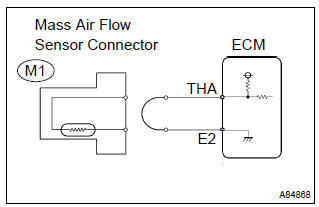
- Disconnect the m1 mass air flow sensor connector
- connect terminals tha and e2 of the mass air flow sensor wire harness side connector.
- turn the ignition switch on.
- select the item ”diagnosis / enhanced obd ii /
data list / all / intake air” and read its value displayed
on the hand–held tester or the obd ii scan tool.
Temperature value: 140 °C (284°f) or more
- reconnect the mass air flow sensor connector.
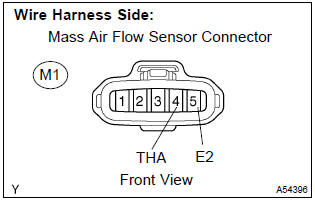


3 Read value of hand–held tester or obd ii scan tool(check for open in ecm)
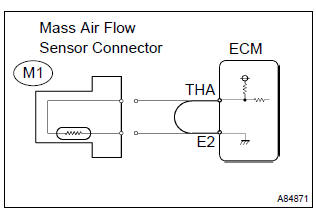
- Disconnect the m1 mass air flow sensor connector.
- connect the terminals tha and e2 of the e3 ecm connector.
Hint
: before checking, do a visual and contact pressure check on the ecm connector.
- turn the ignition switch on.
- select the item ”diagnosis / enhanced obd ii /
data list / all / intake air” and read its value displayed
on the hand–held tester or the obd ii scan tool.
Temperature value: 140 °C (284°f) or more
- reconnect the mass air flow sensor connector.
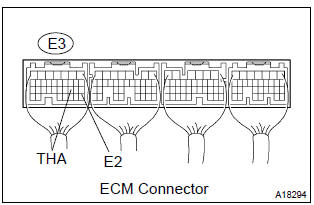


Confirm good connection at ecm. If ok, replace ecm
4 Read value of hand–held tester or obd ii scan tool(check for short in wire harness)
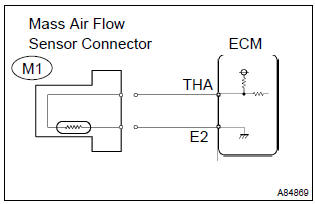
- Disconnect the m1 mass air flow sensor connector.
- turn the ignition switch on.
- select the item ”diagnosis / enhanced obd ii /
data list / all / intake air” and read its value displayed
on the hand–held tester or the obd ii scan tool.
Temperature value: –40 °C (–40°f)
- reconnect the mass air flow sensor connector.


5 Read value of hand–held tester or obd ii scan tool(check for short in ecm)
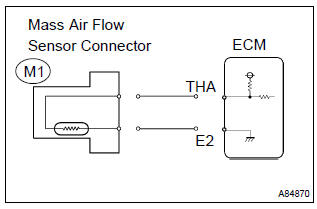
- Disconnect the e3 ecm connector.
- turn the ignition switch on.
- select the item ”diagnosis / enhanced obd ii /
data list / all / intake air” and read its value displayed
on the hand–held tester or the obd ii scan tool.
Temperature value: –40 °C (–40°f)
- reconnect the ecm connector.
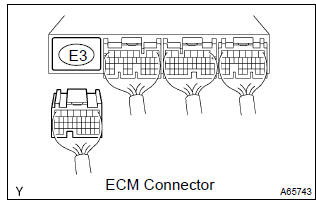


Replace ecm
Other materials:
Rear combination lamp assy lh
Replacement
Using a clipremover, remove the 2 clips and disconnect
the luggage compartment trim cover lh.
Disconnect the connector and remove the 3 nuts.
Pull out the rear combination light assy lh to the back of
the vehicle, and remove.
...
Purpose of the readiness tests
The on–board diagnostic (obd ii) system is designed to monitor the
performance of emission–related
components and report any detected abnormalities in the form of diagnostic
trouble codes
(dtcs). Since the various components need to be monitored during different
driving condition ...
How to proceed with troubleshooting
1 Vehicle brought in
2 Customer problem analysis check and symptom check
3 Problem symptoms table
Without applicable symptoms, proceed to ”a”
with applicable symptoms, proceed to ”b”
4 Perform troubleshooting in the following method, depending on
malfunction symptom ...


